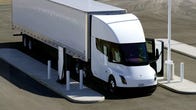[ad_1]
It’s pretty unlikely you’ll buy a Tesla Semi. There are reasons why you should care about the hulking electric vehicle, though.
Chief Executive Elon Musk showed off the truck Thursday night to tout the first shipments of the massive machines to PepsiCo, which ordered 100 Tesla Semis in 2017 when the truck debuted. Tesla missed its initial deadline to start selling Tesla Semis in 2019, but now it’s building them at a factory in Sparks, Nevada.
“It’s a beast,” Musk said of the Tesla Semi, showing a video of one passing other trucks driving uphill with a fully loaded weight of 82,000 pounds.
So no, not a machine most of us will ever drive. But Tesla’s 18-wheeler could be important to us, anyway, as the company continues to push major change in the automotive industry. Here’s why.
The climate
Electric vehicles don’t directly emit carbon dioxide, the main greenhouse gas that’s causing climate change, and as the electrical grid gets greener, power plants also don’t. Transportation accounts for 27% of greenhouse gas emissions in the US, so electrification is a critical step in reaching goals of net zero carbon release.
Trucks are a major part of that change, which is why the US Post Office, UPS and Amazon are all embracing electric trucks for local shipping. Long-haul shipping is harder, though, since bigger batteries are required to reach the Tesla Semi’s 500-mile range.
Semi trucks account for only 1% of vehicle manufacturing in the US, but 20% of emissions, Musk said. “You’ve got a huge vehicle, and it’s being driven all the time,” he said. “The mission of the company is to accelerate sustainable energy.”
That carbon emission advantage is tied to the success of the truck. It isn’t clear how much the Tesla Semis will cost or how many Tesla will make, though in 2017 the company promised a starting price of $150,000.
One big limit will be charging infrastructure. Truck drivers are required to stop periodically, a convenient time to recharge, but until there are lots of charging stations, Tesla Semis will be confined to a limited geography.
Road safety
The Tesla Semi’s electric motor drivetrain, which is computer controlled and can respond rapidly, offers advantages in traction and stability control to make trucks safer for anyone on the road, at least in principle. The truck’s software control system will stop a truck from jackknifing, Musk said.
All that has yet to be put to the test, so it isn’t clear how well the Tesla Semi will meet those ambitions, but it’s true that EVs offer some advantages.
The Tesla Semi, like all electric vehicles, also uses regenerative braking that pumps power back into the battery when slowing down. When driving down long grades, that means brakes don’t overheat.
“That’s why you have runaway-truck lanes,” said Dan Priestley, Tesla’s senior manager tor truck engineering, speaking at the event. With regenerative braking, “It’s a safer system for everybody on the road.”
Another possible safety benefit could come with Tesla’s autonomous vehicle technology. Though it has yet to deliver full level 4 self-driving car tech, Tesla does ship cars that can use the same system for safety features like automatic braking and steering, alerting drivers if they look drowsy, and tightening seat belts if the car expects a collision.
Musk offered no details on autonomous driving technology in the Tesla Semi, though.
Fast charging for Tesla Cybertrucks
To charge a huge Tesla Semi battery, Tesla will operate new drive-through chargers that can pump more than a megawatt of power. That’s enough to charge 10,000 16-inch MacBook Pro laptops at the same time and much higher than ordinary Supercharger stations that today typically offer 150 to 250 kilowatts.
Musk said the high-power charging stations will be available for drivers of Tesla’s Cybertruck, the sharply angular pickup model that’s also suffered years of delay. Its large size compared with Tesla’s Model 3, Y, S, and X vehicles means it’s got a larger battery.
To handle that much electrical flow, the charger’s power cables use internal liquid cooling, Priestley said. “We can shove a lot of current in a very, very small space,” he said.
Cybertruck customers will be able to plug in to the megawatt superchargers starting next year, Priestley said. Tesla plans to start shipping Cybertrucks in 2023, two years later than the initial 2021 start date.
If Tesla chooses to open these high-power charging stations to other vehicle makers, as it’s gradually doing with its more ordinary Superchargers, that could help encourage others to make electric trucks and prompt Tesla to build more charging stations.
As with all things involving Tesla and Musk, there are always a lot of ifs and unknowns. Musk faces new distractions with his Twitter acquisition, has yet to deliver the promised benefits of Full Self Driving Tesla cars, and is struggling to revolutionize transportation with his Boring Company’s tunnels.
But Musk has succeeded overall so far at Tesla and his rocket company, SpaceX. Especially in the long run, the Tesla Semi could be a big deal.
[ad_2]

